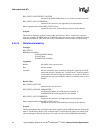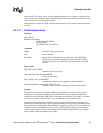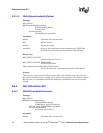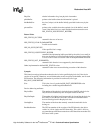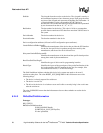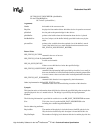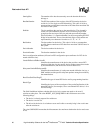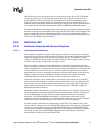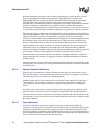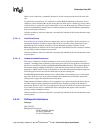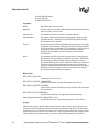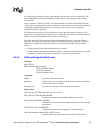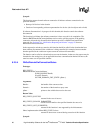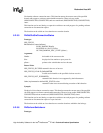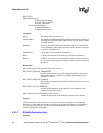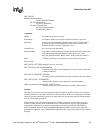
62 High Availability Software for the Intel
®
NetStructure
TM
ZT 4901 Technical Product Specification
Redundant Host API
Software connection is the inverse action to software disconnection: it starts the drivers for PCI
devices in the domain and resumes normal operation. When initiated for a domain in the
DISCONNECTED state, it brings the domain to CONNECTED state through the intermediate
CONNECTING state. Software connection can be used to cancel the effect of software
disconnection for a domain during switchover preparation. For example, suppose that two domains
should be switched over simultaneously in an atomic transaction; software disconnection
succeeded for the first domain but was rejected for the second domain. As a result, the switchover
is not possible and the first domain should be brought back into operation by software connection.
The same states apply to separate slots in the domain. They can be retrieved on a per-slot basis by
separate polling functions or the caller can subscribe for asynchronous notifications about slot state
changes. This makes it possible to invoke partially cooperative switchovers, in which the
switchover is initiated when software disconnection is complete for some (more important) devices
in the domain but not yet for other (less important) devices. These last devices should be reset
during or immediately after the switchover to prevent possible damage to the new owning host.
The requesting host may specify a timeout for software disconnection. This value, expressed in
milliseconds, serves as an indication to the owning host of the time interval during which the
software disconnection should be completed. The requesting host indicates that after the expiration
of the timeout it intends to either abandon the switchover or perform forced switchover.
After the software disconnection of the relevant domains is complete, switchover is initiated to
change ownership of the domains. To trigger the switchover, the RhPerformSwitchover function
should be called.
After the switchover, software connection is automatically initiated for the relevant domains on the
receiving hosts. It is not necessary to call any functions after the switchover to software connect the
received domains.
6.2.5.1.2 Partially Cooperative Switchover
With this type of the switchover, software disconnection takes place for some but not all of the
devices in the domain. It may be considered that some devices need to be prepared for switchover
while other devices may be switched over without preparation.
Another possible scenario is that some devices are considered “more important” and the others
“less important”. The switchover is initiated as soon as software disconnection completes for
“more important” devices, without waiting for completion of preparation for “less important”
devices.
In all these cases, at the moment of switchover some devices are prepared for switchover, while
other devices are not and may need to be brought into a known initial state after the switchover.
After the switchover, software connection is automatically initiated for the relevant domains on the
receiving hosts; so it is not necessary to call any functions after the switchover to software connect
the received domains.
6.2.5.1.3 Forced Switchover
In the forced switchover scenario, the domains are not software disconnected before the
switchover, so device operation is not quiesced and for the device drivers and other software on the
resigning host the PCI devices physically disappear, possibly in the middle of transactions. PCI
devices are generally in an unknown state after the switchover. However, if the parameter Reset is
used in the RhPerformSwitchover function, the PCI buses of the domain are reset, which brings the
devices into the known initial state on the new owner host.



